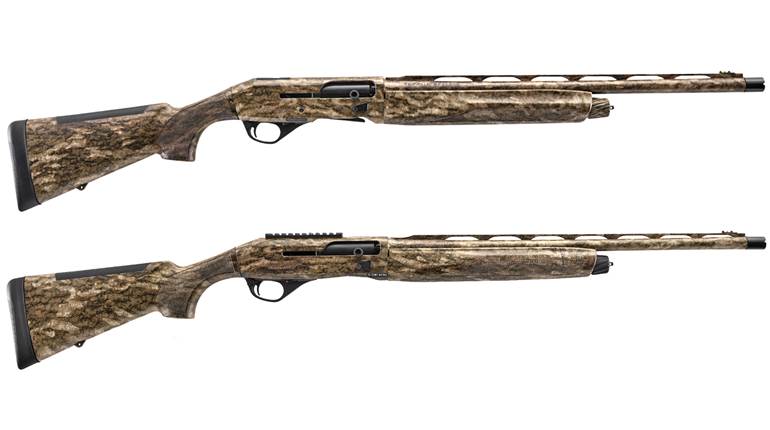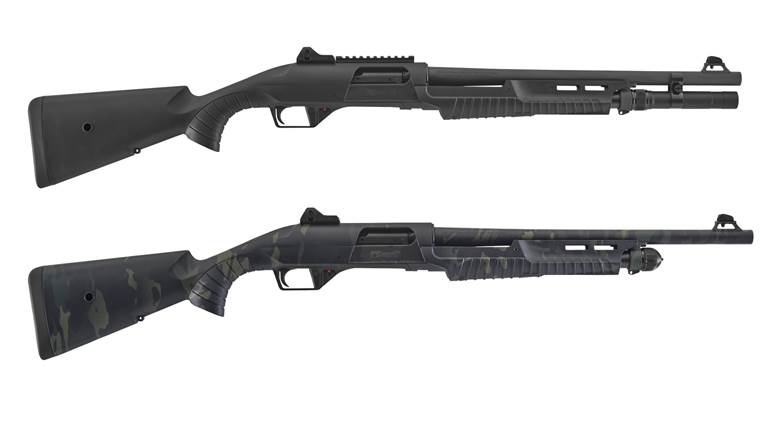
I ripped the top off another box of shells, muttered yet more curses under my breath, and shucked two more of the bright blue cartridges into the magazine as the juking birds mocked me with their aerobatic stunts. Screaming in, then diving, sometimes changing direction, accelerating through six G turns, and then leaving with nary a feather touched. I wondered how a rock pigeon managed to find the time to graduate at the top of its class at the Navy’s Topgun flight school. Then I worked out the lead. They were way faster than I had thought. And then birds started to fall, one after another.
It took a few boxes of shells, the pile of empties growing beside me in the sunflower field near Bloemfontein, South Africa, but my hit percentage went from about a bird per box to hits on every other shot. What struck me as the ring of hulls surrounding me grew was that there was no noticeable effect to my shoulder, no bruising on my face and no cuts on my fingers. That was after a serious morning of high-volume shooting, four hours of loading, swinging and firing as quickly as I could while clad only in a T-shirt. The lack of battering was a testament to the excellent engineering behind the newest shotgun from Benelli: the Ethos.
In the Greek, ethos means character, and Merriam Webster’s defines it as “the distinguishing character, sentiment, moral nature or guiding beliefs of a person, group or institution.”
The Ethos’ aesthetics stand in stark contrast to those of the last autoloading shotgun Benelli introduced: the Vinci. Radical in design with its polymer lower half, it had lines that are, charitably speaking, modern. When I first saw it, I asked “Is it supposed to look that way?” The Ethos, on the other hand, looks as a shotgun should to my tastes; the lines, rendered in blue steel and walnut, are modern, elegant, sleek and clean. There are the expected whooshes and swirls, of course, especially in the polymer trigger guard, but even when disassembled the Ethos looks like a shotgun-not like part of a lawn chair. Indeed, its characteristics and guiding design principles are far from those of its most recent predecessors, matte black or camouflage guns that have dominated in duck blinds, and reflect a modern update of the style and well, ethos, of Benelli’s shotguns.
The tried and true-and often copied-Benelli basics remain. The two-lug bolt head with  its hook extractor on the right will be immediately familiar to anyone who has ever field-stripped a Benelli. The bolt carrier has a tail on its rear that matches up with a cup in the buttstock that contains the recoil spring assembly. Inside the bolt’s body is a massive spring that keeps the bolt in battery until pressures from a fired shell have dropped to safe levels. It is the company’s proven Inertia Driven system, in which the gun moves rearward, but the spring forces the bolt head forward momentarily before allowing it to rotate, starting the extraction, ejection and loading cycle.
its hook extractor on the right will be immediately familiar to anyone who has ever field-stripped a Benelli. The bolt carrier has a tail on its rear that matches up with a cup in the buttstock that contains the recoil spring assembly. Inside the bolt’s body is a massive spring that keeps the bolt in battery until pressures from a fired shell have dropped to safe levels. It is the company’s proven Inertia Driven system, in which the gun moves rearward, but the spring forces the bolt head forward momentarily before allowing it to rotate, starting the extraction, ejection and loading cycle.
What appears to be the upper receiver is a 7075 aluminum alloy cover that press fits over the steel barrel extension, into which the polished, chrome-plated bolt locks. The polished black anodized cover mates up with a recess in the matte lower receiver, also of aluminum. Helpfully, the ejection port on the Ethos is open at its bottom, meaning the bolt handle need not be removed for basic disassembly. At least for now, the stock and fore-end are walnut. All are held together by a fore-end cap, which is of a new “anti-seize” design with a synthetic bushing designed to prevent binding.
The Ethos’ cryogenically treated barrel measures a tight 0.719 inches for most of its length opening up to 0.738 inches just ahead of the choke tube. It includes a gently lengthened forcing cone, and its muzzle accepts Benelli’s Crio interchangeable choke tubes (five are supplied in their own box).
There are, however, tweaks to the basic operating system. Changes to the recoil spring and its cup in the buttstock have resulted in a “dynamic” Inertia Driven System. What that means is that the Ethos will reliably cycle 7/8-ounce, 2¾-inch loads all the way up to 3-inch shells. At home, I ran two boxes of Winchester 7/8-ounce target loads, intended for fixed-breech guns, without a hiccup. The spring-loaded sliding ejector on the barrel extension’s left interior pumped them out with uncharacteristic alacrity.
One complaint against the Inertia Driven system is that if the bolt is not allowed to travel forward with authority, it will not fully lock. If eased forward, a pull of the trigger will result in a conspicuous “click”-one that has cost me a turkey or two. Benelli’s Central Manager and Technical Director, Marco Vignaroli, put his team to work on solving that minor flaw, and they came up with a new cam pin design on the bolt’s left front that ensures it is fully locked if the bolt is closed. It allows Ethos users to check the chamber and not make their gun unlocked and incapable of firing. I deliberately babied the bolt closed time after time, and it works as advertised.
There are a number of seemingly small ergonomic improvements as well that add up to improved accessibility. The most visible is the extended bolt release on the lower receiver’s right front. Measuring 0.69 inches long by 0.20 inches high, it can be hit anywhere along its length even by fingers clad in thick gloves. Also, the shell release latch-on the trigger guard’s right side-is oval shaped and oriented outward. No fumbling trying to reach an awkwardly shaped, inopportunely placed stamping here. It is easy to reach even with gloves on and is a well-thought-out touch.
All the edges where a shooter’s fingers interact with the gun have been radiused, including  the magazine well, the loading port and the ejection port. Also, the Ethos’ shell carrier latch is a new two-piece design that makes loading and unloading easier, so the shooter’s fingers are not under as much spring tension in the loading and unloading process.
the magazine well, the loading port and the ejection port. Also, the Ethos’ shell carrier latch is a new two-piece design that makes loading and unloading easier, so the shooter’s fingers are not under as much spring tension in the loading and unloading process.
Recoil mitigation has been one of the main challenges for Benelli’s engineers. With an Inertia Driven gun, there is no gas bled off to cycle the action. There is less fouling (everything is fired out of the barrel), but there is no recoil reduction, either. On the Super Black Eagle II and the Vinci, the company developed first ComforTech and then ComforTech Plus systems to change and disrupt how the recoil energy is passed on to the shooter. With the Ethos, the new and unobtrusive Progressive Comfort system changes how the recoil is transmitted and perceived. There are no garish chevrons running through the stock, merely a subtle recess between the walnut stock and the buttpad in which the words “Progressive Comfort” are visible. At the back end, there is a well-designed buttpad, soft and squishy where it needs to be and less so at the top where it could interfere with gun mount.
Inside the stock is a cartridge with 20 plastic fingers on each side; think of it as two sets of interlocking ribs. On firing, recoil from a rod at the base of the recoil spring assembly is transmitted to the center of the cartridge. As it moves rearward, it compresses the central fingers against those on the outside. How much compression you get depends on how much recoil is imparted. For a light load, it is minimal, but with a 3-inch waterfowl or turkey load, you get full compression of all the fingers, including the largest at the bottom. And, as this is within the walnut stock, you can’t even tell it is there-until you shoot the gun. This is not a gimmick; it really works.
The other part of the Progressive Comfort equation is a black polyurethane comb insert that snaps into place. It is slick, smooth and allows the gun to slide past the shooter’s cheek under recoil. And the material dampens the recoil impulse to the shooter’s face. Three different heights and shapes of comb are available, allowing a quick, easy change of drop at the comb. Speaking of adjustments, three recoil pad inserts are offered, providing lengths of pull of 13.8 inches, 14.5 inches or 15 inches.
The blend of modern and traditional continues with the barrel rib, which is of gray and black carbon fiber-a light weight material that enhances the gun’s dynamics. Measuring 0.315 inches across, it is retained by small screws and can be easily changed by the user. NRA Publications Editorial Director John Zent took a serious fall while grouse hunting with the sample Ethos, gouging the stock and cracking the rib. Had it been a traditional soldered rib, the incident would have resulted in a gunsmithing job. With the Ethos, it was a simple matter of swapping ribs. Also, there is a white metal mid-rib bead, and there are three colors of fiber-optic inserts (red, yellow and green) for the Ethos’ front bead. Swapping them out is easy; simply pinch and pull. I am typically not a bead watcher-I often remove them-but on long-range pigeons one day in the Orange Free State, I found switching from red to yellow upped my hit percentage by about 10 percent.
The stock is of AA-grade European walnut (generally that means Turkish), that is oil-finished. The wrist and fore-end are checkered at 24 lines per inch with a subtle border. The wrist has a pronounced open radius, thin at its top, with a slight palm swell. The fore-end is well-shaped with a thumb groove that rises through its middle, and its underside is checkered. The gun is light-6 pounds, 9 ounces-with excellent ergonomics and pointability.It drives well to the target, behaving in the hands more like a well-balanced 20 gauge than a 12.
And how did the Ethos do afield? A test group went to Carel Coetxer’s Grassland Safaris in South Africa for some of the most challenging and excellent bird shooting I have experienced, which included three species of dove, rock pigeon, guinea fowl, yellow billed duck, francolin and even a brace of Egyptian geese. It was kind of like taking a new car to a grand prix track. During six days of shooting, 14 pre-production guns fired 17,000 rounds. There was only one malfunction-a distracted writer managed to shove a 23/4-inch shell into the magazine tube backward-which was obviously not the gun’s fault. I have experienced high-volume bird hunting in Argentina, and the lack of a beating allowed by the Ethos was a pleasant surprise. I have been punished more by 20-gauge guns in such situations-let alone 12s-with my cheek bruised, shoulder blackened and bandages on most of my fingers. In short, the Ethos’ performance was excellent, user-friendly and exceeded my expectations. And it looked good, too. Speaking of looks, two models are currently offered: The blue-and-walnut Ethos, with a plain, unadorned receiver; and the Ethos Engraved, with a nickel-plated lower receiver enhanced with tasteful English-style scrollwork on either side of its flats.
The Ethos represents a step forward in semi-automatic shotguns, not only for the engineering innovation present in its design, but for its elegant lines and traditional appearance. They have not been lost and, perhaps, may have even been improved upon. This is a whole-new platform for Benelli, one from which many variations will likely flow. This change in, or rather addition to, the character-or ethos-of Benelli shotguns is a step in the right direction.
Manufacturer: Benelli Armi, S.p.A.Via della Stazione 50, 61029 Urbino, Italy
Importer: Benelli USA, 17603 Indian Head Highway, Accokeek, MD 20607; (301) 283-6981
Mechanism Type: retarded-blowback operated (In-Line Inertia Driven), semi-automatic shotgun
Gauge: 12, 3" (also 2¾")
Receiver: black anodized 7075 aluminum alloy
Overall Length: 49½"
Barrel Length: 26", 28" (tested), 30"
Weight: 6 lbs., 9 ozs.
Magazine Capacity: four
Trigger: single-stage, 6-lb., 2-oz. pull
Stock: AA-grade European walnut with ComforTech Plus: length of pull, 143⁄8"; drop at comb, 1¼"; drop at heel, 17⁄8"
Chokes: interchangeable Crio chokes: cylinder, improved cylinder, modified, improved modified and full
Sights: interchangeable fiber-optic front bead, white metal mid-rib bead
Accessories: five choke tubes, choke-tube wrench, fitted plastic hard case, oil bottle, shim kit for changing cast and drop and magazine plug (other buttpads and comb inserts available at extra cost)
Suggested Retail Price: $1,999 (tested); $2,199 (engraved nickel-plated receiver)
Photos courtesy of Lee Kjos





































